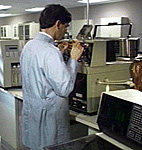|
|
The traditional view of technological development is that innovations arise from fortuitous discoveries, coming about because of the work of independent scientists and engineers. It has been assumed that such discoveries are then applied if they increase industrial productivity, meet market demands and increase profits. In this way inventions lead to innovations, innovations lead to the diffusion of technological products with each technological change leading on from the last in an orderly and inevitable progression as shown in the diagram above. Key points of interest in the history of technology have been who the inventors were, when they made their invention and on what scientific or technological advance the invention was based. Occasionally attention is turned to why some inventions fail to make it as commercial technologies and what the barriers to that progression may be. Technology is therefore seen as merely the fruits of applied science. Technology itself is seen as neutral, a view espoused by Jacques Ellul, who said that technique pursues no end: "It evolves in a purely causal way: the combination of preceding elements furnishes the new technical elements." However this view has been discredited by modern scholars of technology who have shown that the progress toward the wide adoption of a technology is neither smooth, inevitable nor even linear. Many technologies are invented before the scientific principles on which they are based are known (for example the steam engine). Emerging technologies often compete. And the choice of technologies as well as the way they are designed and developed are influenced by social as well as technical factors. Economic determinists claim that technologies are developed and selected to suit the prevailing economic conditions, for example, relative scarcity of land, labour, capital, and the products and services that are developed depend on market demand. Those that are a commercial success in the market are those that are widely adopted. However economic determinism does not explain the development of technologies where there is no profit motive or market demand such as space research, military technology and even medical technology. Nor does it explain why the cheapest means of production is not always the one that is adopted. More recent scholars of technological change tend to argue that the invention and engineering design process is guided and shaped by the goals of the designers and their employers or clients. Therefore, they argue, it is misleading to consider technologies as neutral or the inevitable result of progress. Long before any technology is offered for use on the market, a process of selection occurs that is guided by social and political, as well as economic, considerations.
|

